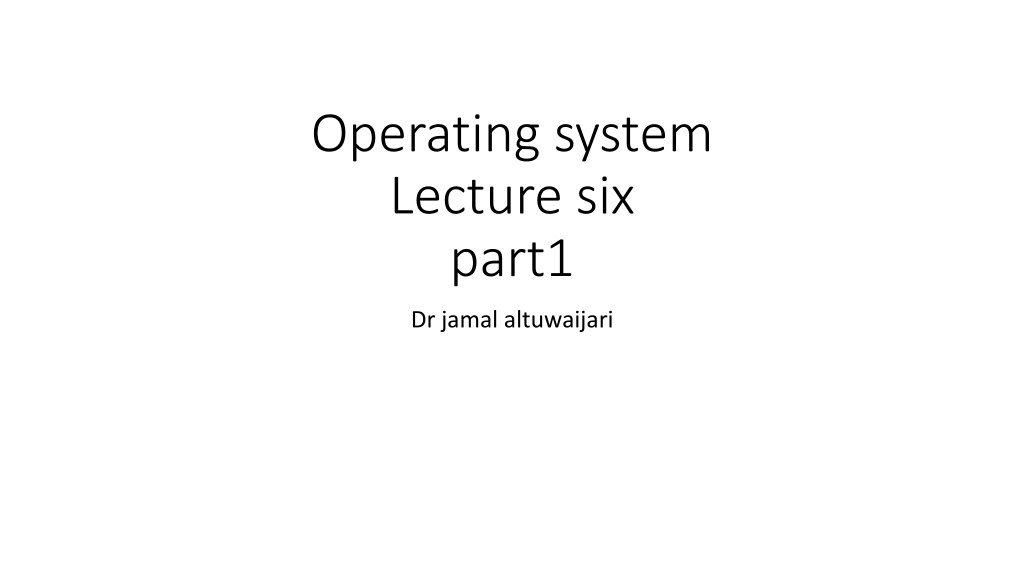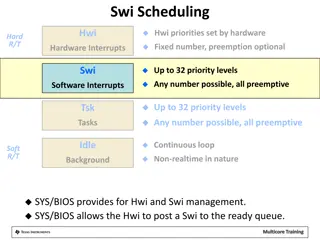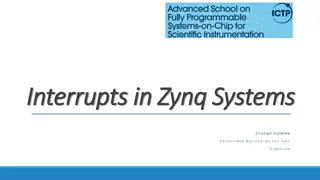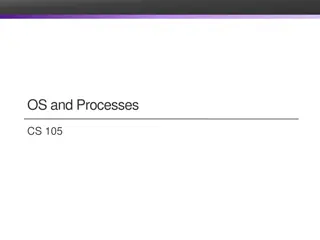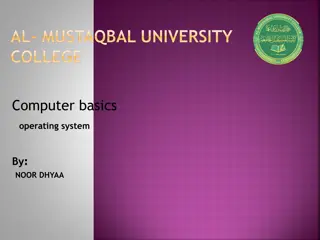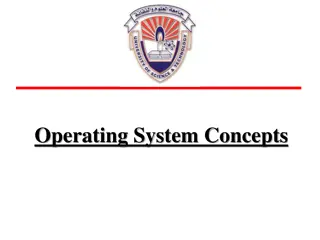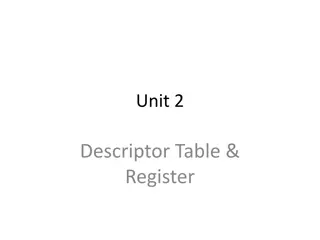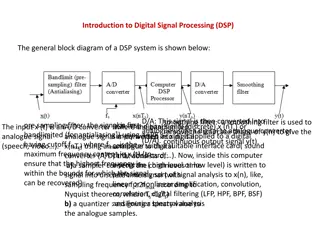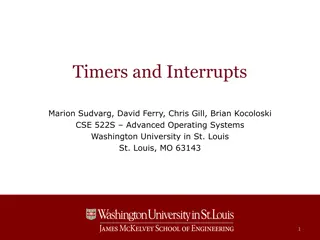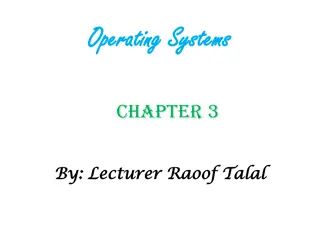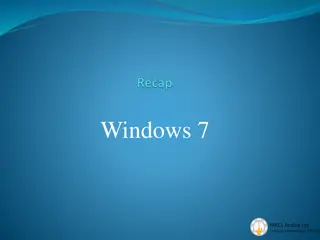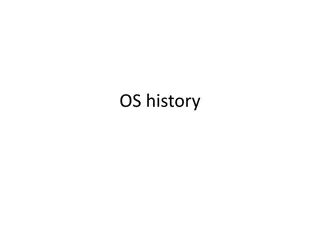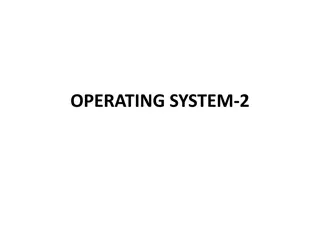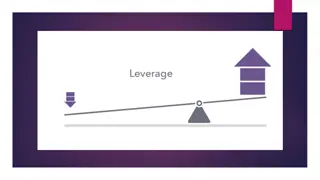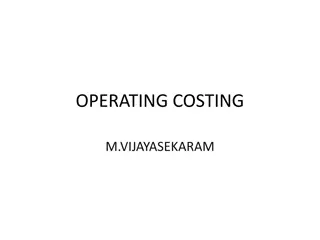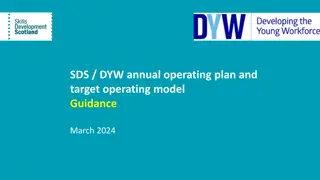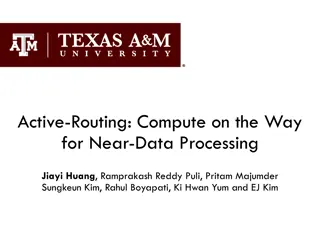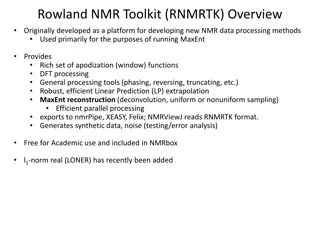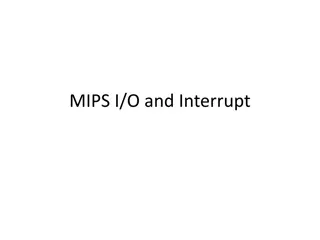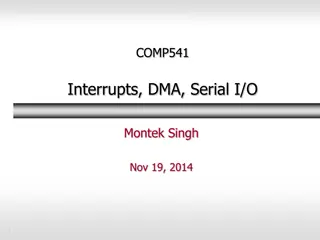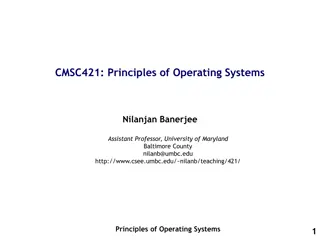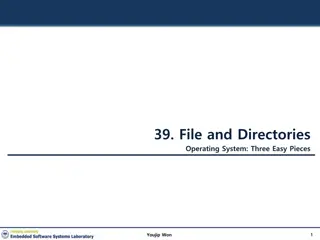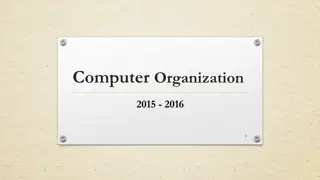Understanding Interrupt Processing in Operating Systems
An interrupt in an operating system disrupts the normal sequence of instructions executed by the processor. When an interrupt occurs, the OS takes control, saves the state of the interrupted process, analyzes the interrupt, and passes control to the appropriate routine. There are six classes of interrupts, including SVC interrupts, I/O interrupts, external interrupts, restart interrupts, program check interrupts, and machine check interrupts. Each type of interrupt is handled by a specific first-level interrupt handler in the OS.
Uploaded on Sep 22, 2024 | 0 Views
Download Presentation

Please find below an Image/Link to download the presentation.
The content on the website is provided AS IS for your information and personal use only. It may not be sold, licensed, or shared on other websites without obtaining consent from the author. Download presentation by click this link. If you encounter any issues during the download, it is possible that the publisher has removed the file from their server.
E N D
Presentation Transcript
Operating system Lecture six part1 Dr jamal altuwaijari
5.11 Interrupt Processing Interrupt Processing An interrupt is an event that alters the sequence in which a processor executes instructions. The interrupt is generated by the HAV of C/S. When an interrupt occurs the following, actions will be taken: a- The 0/S gains control. b- The 0/S saves the state of interrupted process in its PCB. c- The 0/S analyzes the interrupt and passes control to the appropriate routine to handle the interrupt. d- The interrupt handler routine processes the interrupt. e- The state of the interrupted process (or some other next process) is restored. f- The interrupted process (or some other next process) executes. An interrupt may be specifically initiated by a running process (in which case it is often called a trap and said to be synchronous with the operation of the process). Or it may be caused by some event that may or may not be related to the running process. It is said to be asynchronous with the operation of the process.
5.12 5.12 Interrupt Classes (types) Interrupt Classes (types) There are six interrupt classes. These are: SVC /Supervisor call) interrupts 5.12.1 These are initiated by a running process that executes the SVC instruction such as: I/O request Obtaining more storage Communicating with user operator I/O interrupts 5.12.2 These are initiated by the I/O H/W. Such as: - An I/O operation completes. - An I/O error occurs. When a device is made ready.
5.12 5.12 Interrupt Classes (types) Interrupt Classes (types) 5.12.3 External interrupts These are caused by various events including: the expiration of a quantum on an interrupting clock. - Pressing of the console's interrupt key by the operator. - Receipt of a signal from another processor. 5.12.4 Restart interrupts These occurs when the operator: - Presses the console's restart buttom. - When a restart signal processor instruction arrives from another processor on a multi processor system.
5.12 5.12 Interrupt Classes (types) Interrupt Classes (types) 5.12.5 Program check interrupt These are caused by many problems such as: - Divide by zero. - Arithmetic overflow. Data is in the wrong format. - - Attempt to execute invalid operation code. - Attempt to reference a memory location beyond the limits of main memory . - Attempt to execute a privileged instruction Attempt to reference a protected resource - Machine check interrupts 5.12.6 These are caused by malfunctioning H /W
Context Switching Context Switching 5.13 The O/S includes routines called first level interrupt handlers to process each different class of interrupt. Thus there are six first level interrupt handlers. When an interrupt occurs the 0/S save the status of the interrupted process and routes control to the appropriate first level interrupt handler. This is accomplished by a technique called context switching. Program status words (PSWs) control the order of instruction execution and contain various information about the state of a process. There are three types of PSWs, namely: Current PSW's. New PSWs. Old PSWs.
Context Switching Context Switching 5.13 The address of the next instruction to be executed is kept in the current PSW which also indicates the types of interrupts currently enabled and those currently disabled interrupts either remain pending or in some cases arc ignored. On a uniprocessor system there Is only one CPSW but the are six new PSW and six old PSW. When an interrupt occurs the H/W switches PSW's by: Storing CPSW in the OPSW for that type of interrupt. Storing the NPSW V into the CPSW The CPSW now contain the address of appropriate IHR to execute and processes the interrupt
Context Switching Context Switching 5.13
6 6- - CPU scheduling CPU scheduling CPU scheduling is the basic of multi programming O/S by switching the CPU among processes the O/S can make the O/S more productive. For a uniprocessor system these will never be more than one running Process. If there are more processes the rest will have to wait until the CPU is free and can be rescheduled. Scheduling is a fundamental O/S function. Almost all computer resources Are scheduled before use. The CPU is of course one of the primary computer resources thus its scheduling is central to O/S design
6.1 6.1 CPU CPU I/O Burst Cycle I/O Burst Cycle Process execution consists of a cycle of CPU execution and I/O wait. Processes alternate back and forth between these two states. Process execution begin with a CPU burst. That is followed by an I/O burst which is followed by another CPU burst another 110 burst and so on, see the figure 6.1.
6.1 6.1 CPU CPU I/O Burst Cycle I/O Burst Cycle There is a large number of short CPU bursts and there is a small number of long CPU bursts. An I/O bound program would typically have many very short CPU bursts. A CPU bound program night have a few very long CPU bursts. This distribution can be important in the selection of an approximate CPU scheduling algorithm, see Lite figure 6.2 below
6.2 6.2 CPU scheduler CPU scheduler Whenever the CPU becomes idle the 0/S must select one of the processes in the ready queue to be executed. The selection process is carried out by the short term scheduler (or CPU scheduler). The scheduler selects from among the processes in memory that are ready to execute and allocates the CPU to one of them Note: That the ready queue is not necessarily a first in, first out (FIFO) queue. There many scheduling algorithms a ready queue may be implemented as a FIFO, a priority, a tree, or simply an unordered linked list.
6.3 6.3 Preemptive and non Preemptive scheduling Preemptive and non Preemptive scheduling CPU scheduling decisions may take place under the following four circumstances: a. When a process switches from the running state to the waiting state (for example I/O request or invocation of wait for the termination of one of the child processes). b. When the process switches from the running state to the ready state (for example when an interrupt occurs). c. When a process switches from the waiting state to the ready state (for example, completion of I/O). d. When a process terminates. For circumstance I and 4 a new process must be selected for execution. There is a choice for 2 and 3. When scheduling taken place only under I and 4 we say the scheduling scheme is non preemptive otherwise the scheduling scheme is preemptive. Under non preemptive scheduling once the CPU has been allocated to the process, the CPU can not be taken away from the process. A scheduling is preemptive if the CFI) can be taken away from the process.
6.4 6.4 Dispatcher Dispatcher The dispatcher is the module that gives control of the CPU to the process selected by the short term scheduler. This function involves: Switching context. Switching to user mode. Jumping to the proper location in the user program to rattan the program. The dispatcher should be as fast as possible. The time it takes for the dispatcher to stop one process and start another running is known as the dispatch latency.
6.5 6.5 Scheduling criteria Scheduling criteria CPU utilization: CPU utilization may range from 0 to 100%. In a real system it should range from 40%-90%. Through put: it is one measure of work and it is the number of processes that are completed per unit of time. Turnaround time: It is the interval from the time of submission to the time of completion. TAT waiting time + executing time. Waiting time: It is the sum of periods the process spent waiting in the ready queue. Response time : in an interactive system another measure is used which is the response time. It is the time from the submission of a request until the first response is produced
